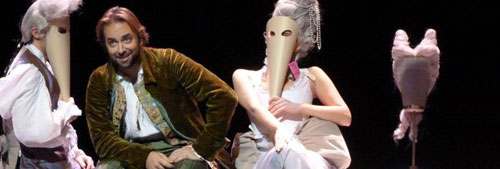Figaro! Figaro! by Wah Keung Chan
/ November 1, 2014
Version française...
Flash version here.

| Largo al factotum della città. |
Make way for the city’s jack-of-all-trades, |
| Presto a bottega che l’alba è già. |
Hurrying to his shop since it’s already dawn. |
| Ah, che bel vivere, che bel piacere |
Ah, what a fine life, what fine pleasure |
| per un barbiere di qualità! di qualità! ... |
For a barber of quality! … |
Gioacchino Rossini hit a jackpot with The Barber of Seville, an opera full of tuneful arias. It’s little wonder that it has never gone out of the repertoire. The most recognizable tune is the intrepid barber Figaro’s opening aria, “Largo al factotum della città” (Make way for the city’s jack-of-all-trades), when he comes on to the scene, literally to the rescue of the lovelorn Count Almaviva.
It’s a 5-minute vocal show piece (stretching over a 12-page vocal score) that is arguably the most feared and challenging aria in the baritone repertoire. Easily found in most opera anthologies, many a student baritone has tried and failed in this aria during his lifetime. “It’s the most stressful aria for baritones because of how high it sits,” says Canadian Etienne Dupuis, who has sung the role of Figaro nine times over three European productions, and who is making his Canadian and hometown role debut in Montreal Opera’s upcoming production. “When it starts, it’s already pretty high,” he explains. “And you know you need to keep your stamina in check because at the end, it’s really quick and high.”
The aria also constitutes the first notes the baritone sings. “So being very nervous is really the worse thing that can happen, because then you have less breath and less time to do what you want to do. The other challenge is that you have to act the whole way through, because nobody expects you to just sing,” Dupuis says.
The sections
The aria can be divided into 6 sections: fast, faster, slow, moderate, fast, and faster, culminating in a long held high G. Baritone Andrew Briggs’s 2014 doctoral thesis analyzed 33 recordings of the aria since 1908 and found many different ornamentations, showing that there is no one ideal version. Dupuis cautions, however, that one should sing it as one long aria: “You have to think of one big thing, not divide it into little segments; otherwise it will be boring. You have to be able to go all the way to the end. If you worry about a part in the middle, you’re doing it wrong.”
Dupuis’s favourite part is in the slow section: “It’s when I sing ‘colla donnetta, col cavaliere.’ It’s where I have the most fun by interacting with audience. This gives you liberty, and you can move around and pause. And it can rest the voice, but not for long.” The most challenging part comes next: “The repeating phrase ‘uno alla volta, per carità’ is a killer because it rises in the baritone’s passaggio in Es and Fs. When you are sick or tired, that’s where you get in trouble.”
Advice
What advice does Dupuis offer to younger baritones? “We all have issues with vowels and vowel placements,” says Dupuis. “The musical line jumps all around, with octave leaps and arpeggios, and it’s hard to keep the proper opening in the throat and mouth to make sure it resonates well. Keep it easy and make sure you’re not pushing. And if it sits higher than what you’re comfortable with, it just gets that much harder. You may try to compensate by giving more energy, you push, and if you do it for just two seconds, you might not be able to finish it. I would focus on relaxing at all times, all vowels placed properly, so that there is less fatigue being created. Then when you master it, you add the acting intentions, which are crucial.”
Dupuis recalls a performance at the Opera de Quebec Gala two years ago, “I was sick and my voice was tired, but the reviews suggested I stole the show. I knew vocally I was weak, so it means that I was in character, and it got me through the performance.”
Barber of Seville
Baritone Étienne Dupuis plays the main role in Rossini’s Il Barbiere di Siviglia at Opéra de Montréal this season. He is joined by Mireille Lebel, Carlo Lepore, Bogdan Mihai, and Paolo Pecchioli. Oriol Tomas is in charge of staging, and Christoph Campestrini is the artistic director. The Orchestre Métropolitain and the Opéra de Montréal Chorus accompany the singers. Salle Wilfrid-Pelletier, Place des Arts, Nov 8, 11, 13, and 15, 7:30 pm.
www.operademontreal.com
Version française... | |

